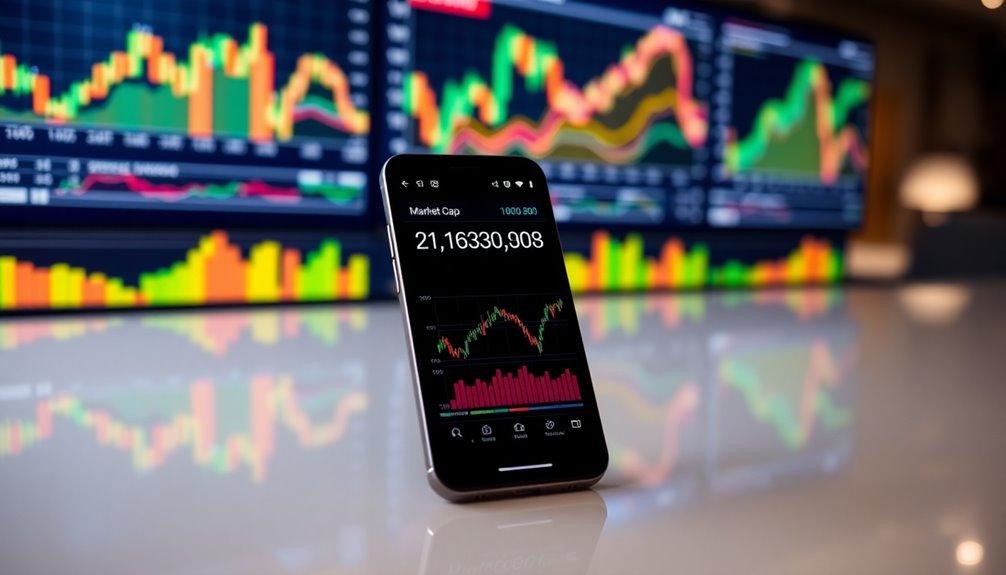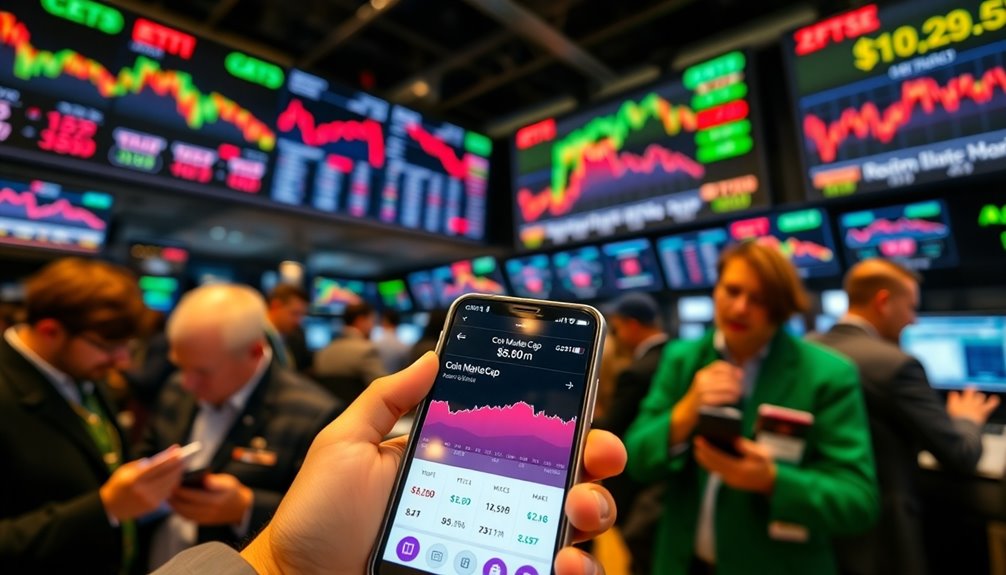Coin market cap refers to the total value of a cryptocurrency, which you calculate by multiplying its current price by the circulating supply. For instance, if Bitcoin trades at $30,000 and has a circulating supply of 19 million, its market cap would be $570 billion. This metric helps you gauge a cryptocurrency's worth and compare it with others. It plays a crucial role in assessing investment risk and potential growth. Understanding market cap can enhance your investment strategy and provide insights into market dynamics. There's more to explore about how this affects your investment decisions.
Key Takeaways
- Coin market cap is the total value of a cryptocurrency, calculated by multiplying the current price per token by its circulating supply.
- It categorizes cryptocurrencies into large-cap, mid-cap, and small-cap, indicating varying levels of risk and growth potential.
- A higher market cap generally suggests more stability and investor confidence in the cryptocurrency.
- Market cap helps compare different cryptocurrencies, providing insights into their overall worth and market dynamics.
- Understanding market cap is crucial for developing informed investment strategies in the volatile cryptocurrency market.
Market Capitalization Explained Simply

Market capitalization, often referred to as market cap, is a key metric that reflects the total value of a cryptocurrency. You can calculate it by multiplying the current price per token by the total number of coins in circulation.
This figure helps you gauge the relative size and growth potential of a cryptocurrency, making it essential for assessing investment risk and potential returns. Understanding market cap categories can help you compare cryptocurrencies based on risk and growth prospects, which is crucial in the rapidly changing crypto environment.
Market cap categorizes cryptocurrencies into large-cap, mid-cap, and small-cap, allowing you to compare them based on risk and growth prospects.
Large-cap coins are typically safer investments, while small-cap coins offer significant growth potential but come with higher volatility.
Understanding market cap is vital for making informed investment decisions in the ever-evolving crypto landscape.
Understanding Market Value Basics

Understanding the basics of market value is crucial for anyone venturing into cryptocurrency investments.
Market cap reflects the total value of all coins in circulation, giving you a clearer picture of a cryptocurrency's scale. It allows you to compare different coins, regardless of their individual prices. A coin priced at $1 can hold more value overall than one priced at $10, depending on its circulating supply.
Larger market caps often indicate more established and stable projects, while smaller caps can offer higher growth potential but come with increased risk. Additionally, the total market cap provides a broader assessment of the cryptocurrency landscape, helping investors gauge overall market trends.
Market Cap Calculation Method

To accurately assess a cryptocurrency's value, you'll need to know how to calculate its market cap. The formula is simple: Market Cap = Price × Circulating Supply.
You'll take the current price per unit of the cryptocurrency and multiply it by the total number of coins currently in circulation. For example, if a cryptocurrency trades at $100 per unit and has a circulating supply of 1 million, its market cap would be $100 million.
Remember, it's crucial to use circulating supply, not total supply, for this calculation, as it reflects the actual value held by investors. This method provides a clear snapshot of a cryptocurrency's overall worth and helps you make informed investment decisions. Understanding the importance of market cap can significantly enhance your investment strategy.
Pros and Cons Overview

While assessing the pros and cons of coin market cap, you'll find that it plays a pivotal role in shaping your investment strategy.
On the upside, increased visibility and improved credibility through listings attract investors and boost liquidity, making it easier for you to buy and sell. Market cap also helps you compare the value potential of different cryptocurrencies, aiding in informed decisions. Additionally, understanding the distinction between circulating supply market cap and fully diluted supply market cap can provide deeper insights into a cryptocurrency's value.
However, it's not without drawbacks. The volatility of prices can lead to significant gains or losses, and market sentiment can skew perceptions, creating misleading impressions.
Small and mid-cap coins carry higher risk, so it's essential to consider these factors as you navigate your investment journey. Be aware of both the opportunities and challenges ahead.
Market Cap vs. Trading Volume

When evaluating cryptocurrencies, it's important to compare market cap and trading volume, as both metrics offer valuable insights into a coin's performance.
Market cap, calculated by multiplying the coin's price by its circulating supply, helps you gauge its overall value and rank within the market. On the other hand, trading volume measures the total amount traded over a specific timeframe, indicating market activity and liquidity.
High trading volume suggests strong interest, making it easier to buy or sell without affecting the price significantly. Additionally, high volume can indicate strong market interest and liquidity, beneficial for investors. By analyzing both, you can assess a coin's risk and potential growth.
Market Volatility Impacts Investments

Market volatility can significantly impact your investment decisions in cryptocurrencies, as rapid price fluctuations often lead to unpredictable outcomes.
Regulatory news, geopolitical events, and central bank actions all contribute to this volatility, making your investments riskier. While Bitcoin's Sharpe ratio indicates potential rewards, its historical highs and lows demonstrate that prices can swing dramatically, sometimes breaching 200% annualized volatility. This volatility exceeds typical levels in conventional assets, as evidenced by the Bitcoin Volatility Index tracking BTC specifically. Additionally, implementing risk management strategies can help mitigate potential losses during turbulent market conditions.
This unpredictability can create opportunities for profit, allowing you to buy low and sell high, or short the asset. However, keep in mind that a larger market cap can lead to reduced volatility over time, suggesting more stability.
Understanding these dynamics is crucial for navigating the crypto landscape and making informed investment choices.
Emerging Altcoin Market Dynamics

Investors are now facing a complex landscape in the altcoin market, shaped by recent trends and shifting dynamics. The market's current cooling-off period has led to decreased transaction volumes, signaling waning enthusiasm among retail investors and smaller institutions. This environment often leads to heightened interest in essential coins that could provide better growth opportunities.
You might notice that altcoins like Cardano have experienced short-lived price surges followed by corrections, underscoring the market's volatility. Larger market caps typically indicate more stability, making these coins less susceptible to manipulation. As a result, market capitalization can be a crucial metric for investors looking to gauge potential risks and rewards.
As you evaluate potential investments, keep in mind that higher market caps suggest resilience to fluctuations. With caution in the air, many investors are waiting for clearer trends before diving deeper into this uncertain yet promising altcoin environment.
Diversify Across Multiple Coins

To navigate the volatile altcoin landscape effectively, diversifying across multiple coins is essential for your investment strategy.
Start by including large-cap cryptocurrencies like Bitcoin and Ethereum, as they generally offer stability. Mid-cap coins, such as Solana, strike a balance between growth and risk. Small-cap altcoins, like Avalanche, can yield high returns but come with increased volatility. Additionally, cryptocurrency portfolio diversification can help mitigate risks by spreading investments across various assets.
Don't forget stablecoins, like USDC, to shield yourself from market fluctuations.
Additionally, consider exposure to various sectors like DeFi, smart contracts, and privacy coins to mitigate risks. Geographic and time diversification further protects you from regulatory uncertainties and market fluctuations.
Frequently Asked Questions
What Are the Top Cryptocurrencies by Market Cap Right Now?
If you're looking into the top cryptocurrencies by market cap, Bitcoin leads the pack with a market cap of nearly $1.92 trillion.
Following closely is Ethereum at about $412 billion.
Tether, XRP, and BNB round out the top five, with market caps of $137 billion, $131 billion, and $101 billion respectively.
Keep an eye on these trends, as prices can fluctuate significantly in just 24 hours.
How Often Is Market Cap Data Updated on Coinmarketcap?
Ever wondered how often market cap data gets updated? Well, you'll be glad to know that market data endpoints refresh every minute!
This frequent updating ensures you're always looking at the latest cryptocurrency prices and volume data.
Plus, historical data gets regular updates, too, so you can analyze trends effectively.
With reliable sources backing this information, you can trust the data for your investment decisions and market analysis.
Can Market Cap Predict Future Cryptocurrency Performance?
Market cap can't predict future cryptocurrency performance, even though it offers a snapshot of current value.
You'll notice that it changes rapidly due to market volatility. While market cap might correlate with some trends, it doesn't account for external factors like market sentiment or economic shifts.
To make informed decisions, you should consider using additional metrics and analyses alongside market cap to gauge potential risks and opportunities effectively.
How Does Coinmarketcap Rank Different Cryptocurrencies?
When you look at how different cryptocurrencies are ranked, you'll notice it's primarily based on market capitalization. They calculate this by multiplying the coin's price by its circulating supply.
To be in the top 200, a crypto must meet specific criteria, like having significant liquidity and being traded on multiple exchanges.
These rankings also consider data integrity and liquidity metrics to ensure fair representation and minimize the impact of inflated volumes.
What Features Does Coinmarketcap Offer Besides Market Cap Data?
When you explore CoinMarketCap, you'll discover a wealth of features beyond market cap data.
You can track your cryptocurrency portfolio, manage exchanges, and engage with community discussions.
You'll access educational resources, historical data, and a fear and greed index.
Plus, you can utilize tools like the price converter and API for deeper analysis.
With all these options, you're equipped to navigate the cryptocurrency landscape effectively and efficiently.
Conclusion
In a nutshell, understanding coin market cap is crucial for making smart investment decisions in the ever-evolving world of cryptocurrency. By grasping the basics, you can better navigate the market's ups and downs—like riding a roller coaster with your hands in the air! Remember to diversify your portfolio across multiple coins to minimize risks and seize opportunities. Stay informed, and you'll be better equipped to tackle the exciting altcoin landscape ahead!









